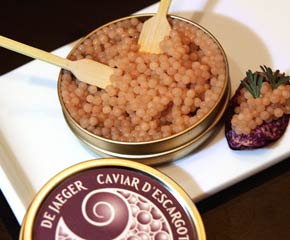Caviar and champagne are a byword for the festive season in France, while a dozen “escargots” or snails cooked in garlic and parsley butter and served in or out of their grey-brown spiralled shells, are a much-loved staple.
But a couple of snail farmers from Soissons, in the Picardie region northeast of Paris, found a way to roll two delicacies into one: their snail caviar, called “De Jaeger”.
Dominique and Sylvie Pierru ditched their old jobs in 2004 to set up their snail farm, and start work on a recipe for caviar.
The next three years were spent perfecting a way to harvest the eggs of their 50,000 gastropods, reared on an open-air diet of herbs and cereals, and to tenderise them without altering the taste.
The result: small, cream-coloured pearls that burst on the palate to reveal what the producers describe as “subtle autumn flavours with woody notes.”
The Pierrus recommend serving the caviar on a sliver of toast, at room temperature, lightly peppered with a touch of sour cream and naturally a glass of chilled champagne.
“It’s completely different from sturgeon caviar, both in terms of appearance and taste,” said Dominique Pierru, fresh back from a French food salon where he said the feedback was “95 percent positive”.
“Chefs are very interested by the colour, the texture and the subtle flavour. It’s a real creative challenge for them.”
Joel Schaeffer, a top chef from Luxembourg, suggests serving the caviar warm in a celeriac soup, or with a thin sliver of truffle, in a cocktail glass layered with creamy celeriac puree and a milk and courgette mousse, garnished with coriander and toasted rosemary brioche.
After tenderising the eggs, the exact process is a trade secret, the Pierrus plunge them in brine with a dash of rosemary essence to each jar, which allows the caviar to keep unpasteurised for three months.
“We are the only people worldwide making snail caviar this way,” Dominique Pierru claims. “But we had to invent everything from scratch.”
“Once gathered, the eggs are cleaned and sorted. Everything is done by hand, which explains the high price,” said Sylvie, in the farm’s laboratory near their family home.

